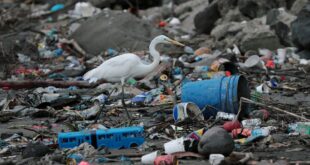Researchers find what they believe is the central church of Rungholt, the ‘Atlantis of the North Sea.’

Rungholt was once a booming trade town where residents reaped profits from the land’s bountiful natural resources — until a changing climate and rising sea levels ripped it all away.
The story may sound eerily familiar, but it happened 661 years ago.
Now — thanks to advancements in technology that allow scientists to identify structures buried deep beneath the Earth’s surface — researchers are learning more about this medieval city that’s been long buried off the coast of Germany.
“This is really a major problem we are facing today in many places of the world with rising sea levels,” says Bente Majchczack, an archeologist from Germany’s Kiel University who is helping to map the ancient town.
“We can see how the people lived there, and how they reacted — and how they ultimately failed — in maintaining this landscape,” he told As It Happens guest host Helen Mann.
‘Atlantis of the North Sea’
Rungholt was a 12th-century Frisian colony that, in the years since its destruction, has gained an almost mythical status. It’s widely known as “the Atlantis of the North Sea” — much to Majchczack’s chagrin.
But while Atlantis is, as far as anyone knows, fictional, Majchczack says Rungholt was a very real Medieval trading hub that met a grisly fate in 1362 when a powerful storm surge completely submerged it.
Its remnants, he says, are buried beneath the muddy flats near the German island of Hallig Südfall in the Wadden Sea.
That’s where he and a team of researchers, funded by the German Research Foundation, are using a combination of geoscientific and archaeological methods to paint a picture of the town.
“We’re doing a magnetic survey,” he said. “And this enables us to find all these buried structures and to map them out really in a black and white map where we can see what’s left of the Middle Ages in this area.”

So far, the team has mapped about 10 square kilometres, including 54 terps — or artificial mounds upon which medieval settlements were built — as well as systematic drainage systems, a sea dike with a tidal gate harbour and two small churches.
But they came upon their most significant discovery last month — the foundations of what they believe was a 40-by-15-metre church built upon a previously unknown two kilometre long chain of terps. This was likely the town’s central church, and a major community hub.
Kiel University geophysicist Dennis Wilken had the eureka moment.
“He was pushing the cart with the magnetic probes and he had found a new terp and was looking at the measurements … and then he realized what he was seeing on the screen,” Majchczack said.
“I wasn’t there. But a colleague said, ‘And suddenly, he started dancing.’ So … it was really a very, very special moment.”
‘The Great Drowning of Men’
What’s interesting about Rungholt, Majchczack says, is that it was built somewhere not at all suitable for human settlement.
“It was like a natural landscape of peat bogs and fenland. It was very uninhabitable, and they completely colonized it. They completely changed the landscape,” he said.
“Once you remove all this peat and get the water out, you have very, very rich soils that are perfect for agriculture … and that must have been quite profitable.”
Profitable, but not, it would seem, sustainable.
“This backfired on them because they created huge vulnerabilities,” Majchczack said. “With rising sea levels and increasing storminess, one day these dikes they built were not sufficient enough, and these settlements just drowned. Everything was destroyed.”
The storm that did Rungholt was a whopper. It swept across Ireland, Britain, the Low Countries, and northern Germany, causing at least 25,000 deaths, according to the Guardian, in an event now known as the Grote Mandrenke — orthe Great Drowning of Men.
Both the storm and the destruction of Rungholt have long captured peoples’ imaginations. For example, Majchczack says stories often paint it as a much bigger city than it actually was.
And one legend that’s been passed down over the ages is that God brought on the storm to punish the residents of Rungholt whose wealth and abundance caused them to live lives of drunkenness, debauchery and sin.
‘A cautionary tale’
Historians have hailed the Rungholt Project for using a multi-disciplinary approach and new technology to unlock the secrets of the past.
Western University historian Mitchell Hammond, who was not involved in the research, says that when Rungholt was being built, the climate was “exceptionally warm” and “expanding populations were resourceful in new exploitation of land and sea.”
“By 1360, the region was well into the so-called ‘Little Ice Age,’ which was not only colder but more to vulnerable disasters like the cyclone flood that apparently wiped out Frisian coastal villages in early 1362. Land-use decisions that seemed sound to coastal dwellers in the 1200s set up later problems,” Hammond, who studies ancient German cities, said in an email.
“It’s a cautionary tale for coastlines today in an era of even more profound climate upheaval. ”
David Perry — a medieval historian based in Minnesota, and co-author of The Bright Ages: A New History of Medieval Europe — agrees.
“This work continues to help redefine our understanding of medieval Europe, including this city on a northerly coast, as a connected, permeable, complex world with connections that stretch across continents and seas,” he said.
“Rungholt and its fate is a human story, and I hope we can always see medieval people as different than us in many ways, but still humans, our fellows, with all the potential for joy and tragedy that the human condition brings.”
*****
Credit belongs to : www.cbc.ca
 Atin Ito First Filipino Community Newspaper in Ontario
Atin Ito First Filipino Community Newspaper in Ontario






